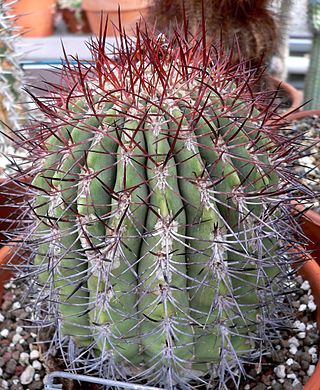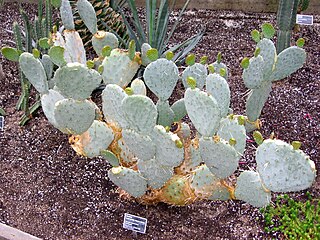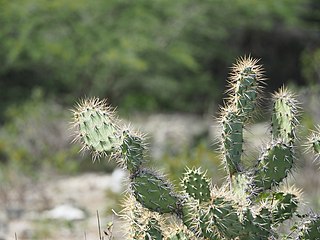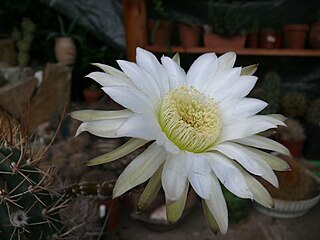
Matucana is a genus of cacti, containing approximately 20 species of mostly globular plants. The genus is known only from Peru, mostly along the Marañón River.

Stetsonia coryne, the toothpick cactus, is the sole species in the cactus genus Stetsonia. Stetsonia coryne is native to arid regions of South America, where it grows to a height of 15 to 25 ft tall. It contains mescaline and other alkaloids.

Trichocereus macrogonus, synonym Echinopsis macrogonus, is a species of cactus found in Ecuador, Peru and Bolivia. Two varieties are accepted as of September 2023: var. macrogonus and var. pachanoi. Plants contain varying amounts of the psychoactive alkaloid mescaline. They have been used both ritually and in traditional medicine from pre-Columbian times. Trichocereus macrogonus is one of a number of similar species that may be called San Pedro cactus. Indigenous names include achuma and huachuma, although these too may be applied to similar species.

Ferocactus pilosus, also known as Mexican lime cactus or Mexican fire barrel, is a species of cactus in North America.

Soehrensia candicans is a species of cactus from northern and western Argentina. It has large fragrant white flowers that open at night.

Oreocereus celsianus, or the old man of the mountain is a member of the family Cactaceae native to the high lands of the Andes in South America, and is named for its fluffy white hair, which may protect it from intense sunlight and extreme temperatures.

Cochemiea goodridgei is a species of plant in the family Cactaceae. It is endemic to Mexican state Baja California.

Ferocactus pottsii is a species of Ferocactus from Mexico. The specific epithet has also been spelt pottsi.

Denmoza is a monotypic genus of cacti. Its only species, Denmoza rhodacantha, is native to northwest Argentina.

Ferocactus haematacanthus is a species of Ferocactus from Mexico.

Lobivia pentlandii, is a species of Lobivia found in Bolivia and Peru.

Echinopsis strigosa, is a species of Soehrensia in the cactus family. It is native to north western Argentina. It was first published in Cactaceae Syst. Init. 28: 31 in 2012.

Lobivia pampana is a species of Lobivia found in Peru.

Opuntia setispina is a species of cactus found in the Sierra Madre Occidental in Chihuahua, Sonora, and Durango in Mexico. The name O. setispina has been listed as a synonym under Opuntia macrorhiza and Opuntia pottsii, but shows no close relationship to either species. It is more of a woody shrubby, often somewhat tree-like species, growing up to approximately 1 meter tall and wide. It is morphologically similar to Opuntia chlorotica, Opuntia santa-rita, and Opuntia gosseliniana.

Opuntia caracassana is a species from the genus Opuntia. The species was originally described by Joseph zu Salm-Reifferscheidt-Dyck in 1850.

Matucana formosa is a species of Matucana found in Peru.

Matucana krahnii is a species of Matucana found in Peru.

Acanthocalycium leucanthum is a species of flowering plant in the cactus family Cactaceae from Argentina.
Matucana hoxeyi is a species of cactus in the genus Matucana, native to Peru.

Echinocereus acifer is a species of Echinocereus found in Mexico


























